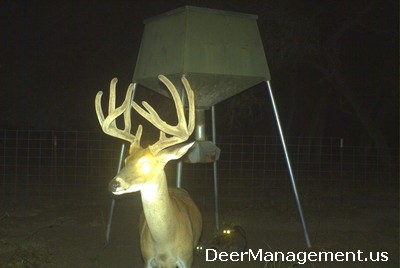Providing optimal white-tailed deer nutrition has become the name of the game with regards to deer management on private properties. Managers know full-well that deer need food, cover and water, but supplemental food is the easiest thing that can be added into a deer’s environment that will create a noticeable difference in antler growth within a short period of time, over the period of an antler growing cycle. When it comes to managing bucks for age, genetics and nutrition, food is the low-hanging fruit (pun-intended).
Hunters and landowners that start feeding high protein foods shortly following the whitetail rut are focused on getting bucks back into tip-top shape. This is the ideal time to supplement natural deer nutrition because quality foods are lowest during the winter period and well-traveled bucks are often in the poorest body condition of the year. Research has found that feeding protein pellets with a 16 to 20 percent protein level can add about an additional 15 percent to a bucks annual Boone and Crockett antler score.

Protein Pellets Not the King of Deer Nutrition
But contrary to what you might think, feeds high in protein are not always the best for white-tailed deer. In nature, there are only three real food groups available to deer: browse, forbs and grasses. By far, whitetail prefer forbs the most. Forbs are really just “weeds.” Not all forbs are consumed by deer, but forbs can be extremely high in protein. In fact, they can be upwards of 35% protein!
That kind of difference in nutrition makes forbs look more like Grade A prime rib and commercially-formulated protein pellets more like oatmeal. In my opinion, promoting quality forbs for whitetail should be the number one goal of landowners managing for white-tailed deer. Nothing else comes close to packing on body weight and antler mass.
Spring Clover Means Solid Nutrition, Bigger Antlers
Source: “A few years ago I had two pens containing whitetail bucks within my research facility. Both groups had always been fed an identical diet. When Spring arrived, one group was in a pen with a lush growth of clover. The other group was in a pen that had been overstocked during the winter and was lacking the new clover. Keep in mind that bucks both pens received all of the high-quality feed they cared to consume. The only difference in the environment or the care from one group to the other was that one group was in a pen with lots of new clover while the other was not.
By mid-May the difference in the two groups of bucks was shocking. The bucks in the pen that had the early clover to supplement their diet were showing advanced antler growth, significant weight gain and a healthier hair coat versus the pen that did not receive the benefit of the clover.
I had long realized that clover is one of the first plants to green up in the early spring. But until I saw for myself what a difference it made in my study herd, I didn’t appreciate just what a huge impact it can have in our efforts as land managers to have the healthiest whitetails on our properties.”
Habitat Management for Whitetail Deer Nutrition
The number one creator of high quality forbs is rainfall, but that doesn’t mean hunters, landowners and property managers are helpless when it comes to developing more of them for deer to eat. It does take rain to grow naturally occurring forbs or food plots planted with clover or other forb mixes, but also habitat can be manipulated to select for additional forb plants for deer. There are a few of ways to improve deer nutrition, increase annual antler growth, and get Spring forbs up and running.
These habitat management techniques include prescribed burning, prescribed grazing, field disking and brush clearing. Prescribed burning just before Spring green-up will promote cool season forbs by reducing old-growth grass cover and putting fertilizer into the ground. Alternatively, high intensity cattle grazing during that time will do the same thing, but without the major increase in fertilizer.
Disking grass-dominated pastures or grasslands prior to Spring will also promote cool season forbs. It’s important to realize that since white-tailed deer eat very little grass (only about 8 percent of a deer’s annual diet), when deer are seen in fields it is often forbs that they are consuming, not grass. Brush management that involves complete clearing or selective clearing will enhance protein-rich forbs that will increase the nutritional plane of a deer herd, but do not target brush that provides good deer browse (leaves, twigs, vines) during the Summer and Winter.